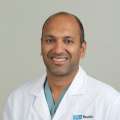Executive Chef Sonny Sweetman is known for his meticulous attention to detail and unwavering culinary artistry. His dedication to the craft is what led him to oversee the kitchen for Oprah Winfrey, Wolfgang Puck, Hotel Bel-Air, and, most recently, Paramount Studios.
So, in early 2022, when he started to occasionally bump into things in the kitchen and experience some blurriness in his vision, he figured he was simply getting older and it might be time for some glasses.
But when the eye doctor suggested he needed to see a specialist and got him an appointment for the next day he knew something wasn’t right.
“I just had this sinking feeling,” said Sweetman. “The doctor had this sense of urgency and I thought there's no doctor in Los Angeles hanging out on a Friday afternoon willing to see somebody for a pair of glasses. That's clearly not good, right?”
Sweetman soon learned that his gut instinct was correct.
He was diagnosed with uveal melanoma, a rare type of cancer that occurs in the eye. The melanoma is derived from the melanocytes in the uvea, accounting for only about 5% of all cases of melanoma in the United States. Only about 1,700 people are diagnosed with this type of cancer each year, according to the National Cancer Institute.
After receiving his diagnosis, Sweetman, 53, a father of two sons and a daughter, was introduced to a team of specialists at UCLA Health who are experts in treating this disease.
“As difficult as cancer is, I just really feel so lucky to be in such gifted hands,” said Sweetman.
A multidisciplinary team of experts
Sweetman’s team was led by investigators in the including Tara McCannel, MD, PhD, director of the Ophthalmic Oncology Center at the and oncologist Bartosz Chmielowski, MD, PhD, clinical professor in the division of hematology/oncology at the .
The team immediately put Sweetman on radiation that helped save his eye and get him back in the kitchen.
Then in April 2023, during one of his routine scans, the team saw that the cancer had metastasized to his liver. About half of patients with this disease will see the cancer spread to other parts of their body, particularly to the liver.
Sweetman was first put in a study testing an oral chemotherapy pill that worked for a while, but it wasn’t able to fight off the cancer long-term.
It was during this time that the Hepzato Kit procedure, a liver-directed treatment, was approved by the U.S. Food and Drug Administration (FDA) and brought to Sweetman’s attention.
A novel therapeutic approach
Unlike traditional chemotherapy, which circulates throughout the entire body, the Hepzato Kit procedure uses a special system to deliver high doses of chemotherapy directly to the liver without exposing the rest of the body to the drugs. This targeted approach means fewer side effects, making the treatment safer and more effective for patients with metastatic uveal melanoma who have liver metastases that cannot be surgically removed.
The complex procedure requires a high level of clinical skill and extensive collaboration across multiple departments including , perfusion and .
The interventional radiologist leads and performs the vascular intervention procedure; the anesthesiologist plays a crucial role in managing the hemodynamic changes associated with this procedure; and the perfusionist monitors and controls the extracorporeal pump and veno-venous bypass circuit.
The UCLA team for this procedure is interventional radiologist Siddharth Padia, MD; anesthesiologist Dane Saksa, MD, MBA; and Kim De La Cruz, CCP, who directs cardiac perfusion services.
“The introduction of the Hepzato Kit represents a cutting-edge and promising development in addressing this challenging condition,” said Dr. Saksa, who is the director of non-operating room anesthesia for UCLA Health. “The goal is to extend survival significantly, with some patients now surpassing two years post-treatment.”
The minimally invasive procedure starts with an infusion of chemotherapy directly into the hepatic artery. Then the blood is drained from the body after it leaves the liver and passes through various special filtration system that filters out all the chemotherapy and then returns the blood back to the patient. The entire process typically takes about three hours, with patients often discharged the following day.
“When patients wake up from the procedure, they're really waking up with just a few Band-Aids,” said Dr. Padia. “There's really no stitches or large incisions involved. Many are able to go back to their everyday life pretty quickly.”
“One of the most unique features about this procedure is it all happens outside of the traditional operating room,” said Dr. Saksa. “It really is an exemplar to other hospitals around the country of what can be done in a less-invasive setting and still be able to make a big difference.”
Because the procedure is highly specialized and requires advanced training, it is only available at select medical centers. Currently, UCLA Health is one of only two hospitals west of the Mississippi that offer this therapy.
Sweetman was among the first patients at UCLA Health to have the procedure after the FDA approval. Patients can receive the therapy up to six times, and Sweetman had the procedure twice. On both occasions, he was discharged from the hospital the next day and returned to work within a week.
Back in the kitchen
Today, Sweetman is back in the kitchen doing what he loves. He credits his medical team for helping him return to work quickly and his team in the kitchen for stepping up and making it easy for him to take care of himself.
“I’ve been working for 30 years doing what I love and I never really have missed work,” Sweetman said. “I show up and I show up early. So, I really had to rely on my team to get me through this because I couldn’t be there every day. It was a bit of a transition and everyone has supported me so much. It’s really humbling.”
As for his medical team, Sweetman calls them “magical humans” whom he can’t thank enough.
“Everyone from UCLA has talked about the importance of quality of life, getting back to living your life and not letting cancer control you. And that's what I've experienced,” said Sweetman. “I felt valued, respected and safe. I couldn’t have asked for a better team.”
Take the Next Step
Learn more about Interventional Radiology and Cancer Services at UCLA Health.








